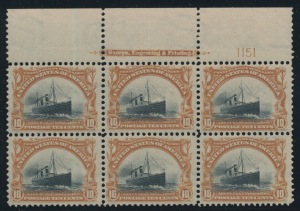Each Country has quirky collecting habits related to how their stamps were printed and to the marginal markings that originally contained printer's information or advertising. Israeli collectors collect their stamps with tabs, which are inscriptions that appear in the margins and which are collected attached to the stamps themselves. French collectors collect milliseme pairs, which are margin pairs with plate numbers between the two stamps. These pairs are from large sheets that were later cut into panes to be sold at the Post Office. British collectors collect gutter pairs with color registration markings-these are called traffic light gutter pairs because of the colorful display in the margins.
The most popular and significant of all marginal markings that have gained collector popularity is the collecting of plate blocks by US collectors. Plate numbers, as they relate to most US plate blocks, began in the 1890s (earlier stamp plates sometimes had plate numbers, but they were not numbered consecutively over time). Until then, stamps were printed by government contract, with the contract changing often as printers were replaced by others who bid the contract lower, or through attrition and mergers and acquisitions. In 1894, the Post Office finally decided that going forward all of our stamps would be printed by the government Bureau of Engraving and Printing (BEP). The first sheet that the BEP prepared for postage stamps was numbered plate #1 and then went consecutively from there. Early collectors tried to get a single attached to plate number. By about 1900, the fashion had changed to collecting the plate number and the stamps in strips of three to show both the plate number and the Bureau's imprint . By 1910, fashion again had changed, and this time protocol was to collect the stamps that were adjacent to the three on the plate number strip, creating the plate block of six. This became the standard for plate block collectors in the flat press period.
Because the standards of plate number collecting changed dramatically in the first twenty years of plate number collecting- going from plate number singles to strips of three to blocks of six- the number of surviving early plate blocks of six are very small. The earliest plate number collectors, and there were a few of them, had only saved strips. As the collecting fashion changed to plate number blocks of six, dealers had to go back to the few remaining sheets to create them. This is why the earliest plate blocks are so rare- it's not that there weren't many collectors in this period saving plate numbers. They were just collecting them in a way that fell out of fashion.
For many years plate block collecting rivaled single collecting in popularity among US collectors. Many collectors collected only plate blocks, eschewing singles entirely. This fashion has now changed. The common sheet format of most US stamps now is sheets of twenty. It is this new format that the former plate block collectors now collect, and this has made traditional plate block collecting less common.

